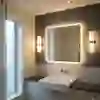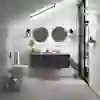Share:
With shorter days and longer nights in the UK, preparing your home for winter lighting is crucial. As natural light becomes scarce, especially during early mornings and late afternoons, the right bathroom lighting is essential for both function and style.
Good bathroom lighting allows everyone to perform daily tasks more efficiently, such as applying makeup accurately or shaving clearly. The correct lighting also highlights bathroom fixtures, making them look their best. Since safe bathroom lighting must balance both bright, practical illumination and comforting ambient effects, it's vital to understand how each type specifically benefits the space.
Whether you're renovating your bathroom or simply looking to upgrade your lighting to banish the winter gloom, The Bathroom Showroom has got you covered! Here, we offer expert guidance on how to light a bathroom correctly, enabling you to create the perfect, safe, and welcoming lighting scheme with ease.

Safety First: Understanding UK Bathroom Zones & IP Ratings
Due to the presence of water and steam, UK electrical regulations (IEE Wiring Regulations) divide a bathroom into zones. Every light fitting must have an IP (Ingress Protection) rating that corresponds to the zone it's installed in.
Zone 0
- Location: Inside the bath or shower tray/basin.
- IP Requirement: IP67 Protected against temporary immersion and Max 12V
- Example: Submersible LED strip.
Zone 1
- Location: Directly above the bath/shower, up to 2.25m from the floor.
- IP Requirement: IP44 Protected against splashing is the minimum, but IP65 is highly recommended.
- Example: Shower downlights.
Zone 2
- Location: Area 0.6m outside the perimeter of the bath/shower, and 0.6m radius around the wash basin tap.
- IP Requirement: IP44 Protected against splashing
- Example: Wall sconces, mirror lights.
Outside Zones
- Location: Anywhere outside Zones 0, 1, and 2.
- IP Requirement: IP20 is generally acceptable, but IP44 is often recommended for peace of mind against general steam/splashing.
- Example: General ceiling lights.
Pro Tip: If you use water jets for cleaning, or have a wet room, it's best to treat the entire area as Zone 1 and choose IP65 rated lights for maximum safety.

Functionality: The Layered Lighting Scheme
Relying on a single ceiling light will create harsh shadows. A well-designed bathroom uses three layers of lighting to ensure both function and mood are covered
1. Ambient (General) Lighting
- Purpose: To light the whole room evenly and set the overall tone.
- Placement: Evenly spaced across the ceiling, avoiding directly above the vanity.
- Fixture Type: Recessed downlights, flush-mount ceiling lights, LED panels.
2. Task (Grooming) Lighting
- Purpose: Provides bright, focused light for practical activities like shaving and applying makeup.
- Placement: On either side of the mirror at eye level to eliminate shadows.
- Fixture Type: LED vanity light bars, wall sconces, illuminated mirrors.
3. Accent (Mood/Style) Lighting
- Purpose: To highlight architectural features, décor, or create a relaxing atmosphere.
- Placement: Inside shower niches, under floating vanity units, or around the base of a bath.
- Fixture Type: LED strip lights IP rated subtle wall washers.
Pro Advice: Consider installing dimmer switches on your ambient (and ideally accent) lighting to easily transition the room from a bright, functional space in the morning to a soft, spa-like retreat in the evening.

Aesthetics: Choosing the Right Light Colour
The colour temperature of the light (measured in Kelvin, or 'K') dramatically affects the room's atmosphere.
Warm White 2700K - 3000K
Colour Appearance: Soft, slightly yellow.
Best For: Relaxation and a cosy, spa-like ambience. Also flattering to skin tones.
Typical Use: Accent lighting, lighting around the bathtub.
Cool/Natural White 4000K - 5000K
Colour Appearance: Bright, crisp white.
Best For: Tasks that require high clarity and focus, mimicking natural daylight.
Typical Use: Vanity/mirror task lighting, main ambient light (if you prefer a clinical, bright start to the day).
Advice for Best Practice: Use a cooler temperature (4000K) for your mirror/task lighting, and a warmer temperature (2700K-3000K) for your ambient or accent lighting to give you the best of both worlds.

Key Safety and Maintenance Tips for Bathroom Lighting
While selecting the correct IP rating ensures safety during installation, proper maintenance and awareness of potential hazards are essential for long-term safety in a moisture-rich environment like a UK bathroom.
Here we offer a handy list of safety and compliance do's and don'ts.
- Always Use a Professional: Electrical work in a bathroom must comply with UK Building Regulations (specifically Part P) and the IET Wiring Regulations BS 7671.
Do: Hire an electrician registered with a Competent Person Scheme (e.g., NICEIC or ELECSA)
Don't: Attempt DIY wiring or installation in Zones 0, 1, or 2.
- Insist on RCD Protection: RCDs (Residual Current Devices) cut off electricity instantly during a fault.
Do: Ensure your electrician has installed 30mA RCD protection for all circuits supplying the bathroom.
- Position Switches Safely: Light switches and pull-cord switches should be installed outside Zones 0, 1, and 2.
Rule of Thumb: Your light switch should be at least 0.6m 60cm away from the edge of the bath or shower.
- Check the IP Rating: Before purchasing or replacing any light, re-verify the IP rating matches or exceeds the requirement for the specific zone it will be installed in.

Routine Maintenance and Cleaning
- Power Off First: Always switch off the power at the main circuit breaker/fuse box before cleaning, replacing a bulb, or inspecting any fixture. The wall switch is not enough.
- Allow Cooling Time: Let any bulb or fixture cool down completely before touching it to prevent burns.
- Maintain IP Seals: The water resistance of IP rated fixtures relies on secure seals, screws, and retaining rings.
Do: Ensure all covers, diffusers, and screw rings are fully and securely refitted after changing a bulb to maintain the IP rating.
Don't: Use excessive force that could damage or crack the plastic or glass seals.
- Clean Regularly: Dust and water spots dull the light and can affect the fixture's cooling.
Cleaning Method: Wipe fixtures, bulbs, and shades with a soft, lint-free cloth that is only slightly damp (well-wrung out).
Avoid: Spraying cleaner directly onto the fixture, as liquid can seep into the wiring. Avoid harsh, abrasive chemicals that can degrade plastic or chrome finishes.
- Ensure Good Ventilation: Use your extractor fan before, during, and after showering to minimise steam and moisture build-up, which can lead to corrosion and shorten the lifespan of electrical components.

When to Replace (Warning Signs)
Immediate professional inspection or replacement is necessary if you observe any of the following:
- Flickering or Dimming: If a light flickers or dims even after changing the bulb, it may indicate a loose connection or a faulty fixture/wiring.
- Strange Noises or Smell: Any humming, sizzling, buzzing, or, most critically, a burning smell (like plastic) means there is a live current fault. Turn the power off immediately.
- Excessive Heat: If the fixture housing is extremely hot to the touch (beyond normal bulb heat), it suggests a wiring issue.
- Visible Damage: Look for signs of water ingress, rust, corrosion on metal parts, discoloration (scorching) around the light fitting, or cracked glass/plastic seals.
- Frequent Burnouts: If the same bulb location requires replacement much more often than others, the fixture's internal components or wiring may be at fault.
Bathroom Lighting: Frequently Asked Questions
Safety, Regulations, and IP Ratings
- Do I need special lights for my bathroom?
Yes. Standard indoor lights are generally unsafe and non-compliant in wet areas. You must use fittings with an appropriate IP (Ingress Protection) rating based on their distance from water sources (zones).
- What does the IP rating mean?
It's a two-digit code (IPXX) that indicates a light's resistance to solids (first digit, e.g. dust) and water (second digit). The second digit is crucial for bathrooms.
- What are the Bathroom Safety Zones and required IP ratings?
Zone 0 (Inside the bath/shower): Must be IP67 minimum and low voltage (max 12V).
Zone 1 (Above the bath/shower, up to 2.25m): Minimum IP44, but IP65 is recommended for fixtures exposed to direct water spray.
Zone 2 (0.6m perimeter around Zone 1 and the sink taps): Minimum IP44.
Outside Zones (Beyond Zone 2): No specific legal IP requirement, but IP20 or IP44 is often advised for protection against steam and condensation.
- Can I install the lights myself?
It is highly recommended to use a qualified electrician to install or modify bathroom lighting. They will ensure compliance with electrical safety regulations and provide a necessary installation certificate.
Design, Function, and Colour Temperature
- What is the best colour temperature (Kelvin/K) for a bathroom?
The best choice depends on the light's function:
- Task Lighting (Grooming areas): 3500K to 4500K (Neutral/Cool White) provides bright, clear light ideal for applying makeup or shaving.
- Ambient/Mood Lighting (Relaxation areas): 2700K to 3000K (Warm White) creates a soft, cosy, and flattering atmosphere.
- How should I light my bathroom?
Use layered lighting for maximum function and mood flexibility:
- Ambient: General overhead illumination (e.g. ceiling light or downlights).
- Task: Focused, shadow-free light at the vanity mirror (e.g. vertical sconces on either side or an illuminated mirror).
- Accent: Decorative lighting to highlight features (e.g. LED strips under cabinets).
- How bright should the light be (Lumens)?
A general guideline for ambient light is around 250 lumens per square meter. Task lighting at the mirror should be notably brighter.
- Are LED lights suitable?
Yes. LEDs are the recommended choice due to their energy efficiency, long lifespan, and ability to be manufactured with the correct IP ratings and high Colour Rendering Index (CRI), which is important for colour accuracy (e.g. for makeup).
Buy Lighting at The Bathroom Showroom
Visit The Bathroom Showroom today to explore a full range of high-quality, safety-compliant lighting options. With our expert guidance, you'll create an environment that everyone will enjoy using daily, regardless of the weather outside.
By applying the principles of layered lighting and selecting the correct IP-rated fixtures, you can achieve a bathroom that is not just compliant and safe, but also a sanctuary of light.
A well-illuminated bathroom will ensure enhanced functionality and safety for everyone, helping to brighten those dark UK winter mornings and providing a warm, relaxing atmosphere for evening unwinding.
If you’re looking for further help with choosing and installing bathroom lighting, book an appointment with The Bathroom Showroom. Experts in all things bathrooms, we can help turn your dream bathroom into a reality.